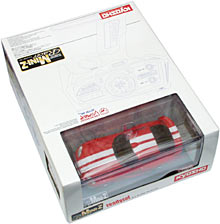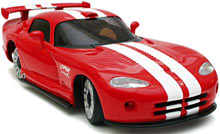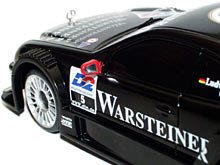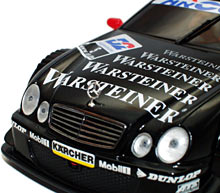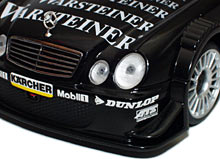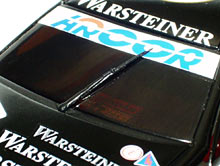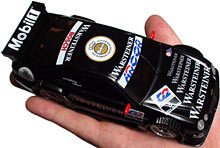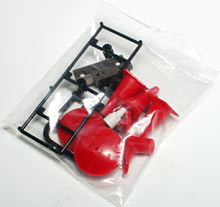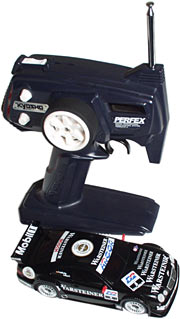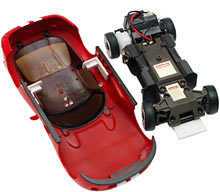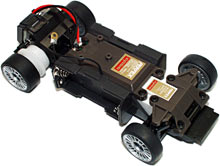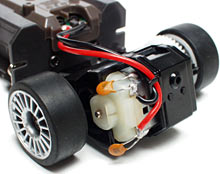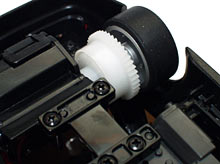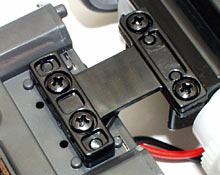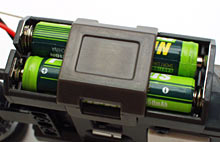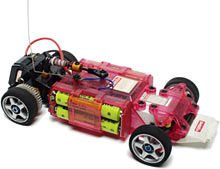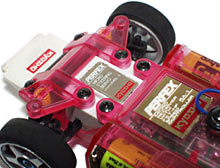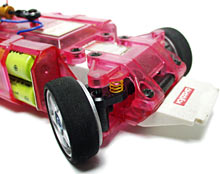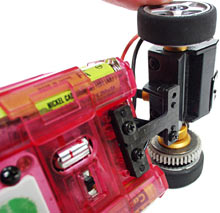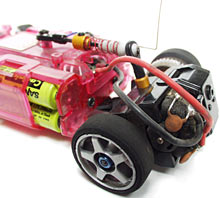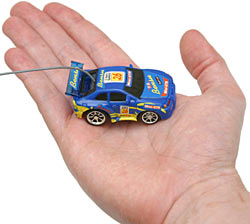
Kyosho Mini-Z Racers
Review date: 5 January 2002.Last modified 03-Dec-2011.
The first thing people tend to say when they see "proper" radio controlled 1/10th, 1/8th or 1/12th scale cars racing is "Wow! Those things are fast!"
And they are, too.
The record speeds for somewhat impractical R/C vehicles are up around 160 kilometres per hour.
A hundred miles an hour.
Seriously.
Backing off from the speed-for-the-sake-of-it brigade, both electric and internal combustion powered R/C cars that are actually used for racing can top 100km/h, when geared high enough. They're not usually set up that way, because the tracks they run on are seldom open enough to make top speeds like that useful, but it's really not all that hard.
When you hit the boards after missing a turn, they're hard. And concrete gutters; they're hard too.
But getting an R/C car to go fast enough that it'll violently "re-kit" itself if it slams into a tree at top speed - all that takes is money.
You can get some, ah, quite advanced gear off the shelf these days, if laughably overpowered and largely uncontrollable rubber-shredding suicidal toys are your thing.
Which is great, and all, but these are hardly toys you can buzz around in your lounge room. Never mind the serious racing cars and three horsepower monster trucks; even a basic entry level 10th scale backyard basher has enough speed to break either furniture or itself in collisions, and the three-step mechanical speed controllers that cheap R/C kits come with don't give you any speed options between "stationary" and "already too fast".
If you want to race even basic 1/10th scale cars, you need a park or a parking lot, depending on whether you're running off-road or on-road. If it's weeing with rain, your options contract dramatically. If you can't be bothered going out at all, and you don't live somewhere with a ballroom, your options vanish.
It'd be nice to be able to just drop some plastic plate corner markers on the linoleum of a decent-sized kitchen and go racing for half an hour with no fuss. None of the usual kinds of R/C cars cut it for this. What you need are little teeny cars that run for a decent amount of time from cheap batteries, which have sufficient power to be interesting to drive (full traction all the time is boring), and which have the same basic features as "proper" R/C racers. Proportional throttle and steering. Replaceable parts. Configurable suspension behaviour. Exchangeable bodies so you can tell which one's yours. And a reasonable price, too, if possible.
Well, take a look to the right, and then take your pick. Plenty to choose from.
These 1/24th scale cars have a roughly 90mm (3.5 inch) wheelbase and look, at a glance, like static display models.
Pretty good static display models, actually.
But they're all radio controlled, and they've got all of the features described above. Including the not-too-terrifying price. They're Kyosho Mini-Z Racers, and they're 1/24th scale R/C cars which are both fun to drive and affordable.
Well, fairly affordable.
When I first wrote this review, my sponsors Aus PC Market were selling Mini-Zs for $AU278.30, delivered within Australia. They're not any more, but that's still a pretty representative price for this boxed version; you get the car, the pre-decorated body, and the radio gear. All you need to add are eight AA cells for the transmitter (alkaline or rechargeable) and four AAA cells for the car (rechargeable, by preference, but alkalines will do in a pinch), and a charger to suit if you're using rechargeables, and you're away. The cars are very nearly ready to run right out of their natty little display box.
What do you get for your money, exactly?
Glad you asked.
Inside the box
Mini-Z cars can accept various 1/24th scale bodyshells; bodies made for them have the right little clips built in, but it's not very hard to modify plastic bodies from other 1/24th scale static car models to suit.
If you measure the Mini-Z's chassis dimensions then its scale works out at more like 1:28, by the way. But what's 16% between friends.
This Mini-Z happens to look like a Dodge Viper GTS/R. Well, actually it looks like the rumoured upcoming production version of the 500 horsepower GTS/R rather than the "concept car" original, but never mind. Big thrusting red thing with racing stripes and a wing. Hey, it could be worse.
The only thing about the Mini-Z Viper that looks particularly wrong are the tyres, which are too narrow; the real car's wheels barely fit inside its bulging wheel arches, while this model's wheels are much thinner. There's a good reason for this, though; keeping the tyres inside the bodywork makes it much harder to break something important when you crash. Which you will.
The Viper's body is quite simple compared with some of the fancier Mini-Zs. This tiny Benz is replete with twiddly bits...
...from the side mirrors...
...to the bonnet emblem...
...to the headlights...
...and, indeed, the wiper blade.
Picking a body like this for racing isn't the greatest idea, if you want it to stay pretty; the protruding bits will get knocked off. But it's the work of a moment to swap between a pretty display body and a scratched and dinged racing one. All of the Kyosho bodies, and pretty much every other 1/24th scale body too, are made of moulded plastic that's thick enough to keep the chassis very safe, thanks to the quite solid mounting system. These little tackers are very crashable. That's a good thing.
Despite its detail, the baby Benz is no bigger than any of the other Mini-Zs...
...and it comes with some suitably teeny accessories.
All Mini-Z cars come with this little extras bag. It contains a couple of battery retaining clips, a little combination wheel nut wrench and pinion removing lever, three different sized pinions and spacers to put under the motor to keep the gear mesh right when you're using them, and a different motor mount piece for the high-motor rear pod configuration. Plus six scale red plastic racetrack markers - three corner discs, three witches' hats.
Mini-Zs are dwarfed by their transmitters.
The radio systems are standard 27MHz AM, which means you can just swap crystals in the transmitter and the car to be able to run up to six Mini-Zs at once.
The transmitter has the "wheel" design that most model car racers prefer; your right hand turns the rubber-rimmed wheel to steer, and your left hand pulls the trigger to go and pushes it to stop and reverse. Both steering and speed control are fully proportional; if the car jerks and twitches, it's probably your fault, not the electronics.
This transmitter's got steering and throttle trim knobs, which let you get the centre point for each control just right, and it's also got a steering rate thumbwheel, beneath the steering wheel. Steering rate determines the amount of steering you get by turning the wheel as far as it'll go, and it lets you dial down the steering sensitivity for racing. And tweak it back up if you've speared off into the bushes and now need a three point turn, pronto.
Out of the carton, Mini-Z cars are screwed into their display boxes, but they're easy enough to extract. Then you just unclip the bodyshell - two side clips, one front tab-in-slot arrangement - and the chassis is revealed.
The plain Mini-Z chassis is very nearly complete. You just have to screw the provided wire antenna in place and pop in some batteries and you're ready to go.
Starting at the back, there's a 130-size motor with a simple press-on pinion; there's not enough torque here that the pinion gear needs a setscrew or other more serious retaining system. You get three different-sized spare pinions with the car, attached to a simple plastic sprue; this lets you gear the car higher or lower, for different tracks.
You're talking around 15 kilometres an hour top speed for a stock Mini-Z with ordinary gearing, by the way, which means hopping up your motor is not something you're necessarily going to feel any need to do, ever. 15km/h for a 1:24th scale car is a scale speed of 360km/h; a Mini-Z takes the same amount of time to drive its own length at 15 as a full-sized car would at 360. In most domestic driving situations, by the time you get a stock Mini-Z to top speed, you no longer have time to turn.
If you're wondering what the things look like in flight, there are a few movies online. Here, for instance. And also here, where it is demonstrated that areas in which humans can't even stand upright are still acceptable for Mini-Z racing.
On the far side of the motor pod in the above picture is the differential...
...which you can see in more detail in this shot of the underside of the Mercedes Mini-Z, which comes with somewhat wider tyres than the Viper.
The diff is a simple planetary-gear unit that works well on grippy surfaces, but lets the car unload power into whatever wheel has the least grip, on slippery ones. The standard tyres are fairly hard, by R/C racing standards; they'll last well, but they make the Mini-Z's handling on polished floorboards (or similar dead smooth tracks) quite exciting. If you feel like doing some rally-car helicopters, put a spoonful of water on the kitchen floor and go for it.
The motor pod is reconfigurable; you can easily change the motor position so it's sitting above the axle rather than behind it. This lets you mount shorter bodies with a more wheel-at-each-corner layout (Mini Cooper, Volkswagen Golf...) on the Mini-Z chassis.
You can also change the Mini-Z chassis wheelbase by changing the mounting holes used by the T-piece that connects the motor pod to the middle chassis. The Mini-Z chassis' rear wheels are mounted on an unsuspended axle, but the whole rear pod, complete with motor, can bounce and twist relative to the rest of the chassis. This keeps the Mini-Zs much more firmly planted than your average no-suspension toy car, even though they're a lot faster. Mini-Zs are still not off-roaders by any stretch of the imagination certain whimsical modifications notwithstanding); their wheels are a little less than an inch in diameter, after all, and there's only about five millimetres of ground clearance. But they can deal with textured floors and flat-pile carpet OK, and they settle down well after whanging off furniture or other cars.
The Mini-Z's fire-breathing power source is four AAA cells, which should be rechargeable if you want the same speed for the whole run.
AAA alkaline (or even dry) cells have a nominal voltage of 1.5 volts per cell, versus only 1.2 volts for nickel cadmium (NiCd) and nickel metal hydride (NiMH) cells. But the stock Mini-Z motor and speed controller have a peak draw of more than an amp, which is way more than non-rechargeable AAAs can handle. What this means is that the battery voltage will fall through the floor under load, the actual power delivered will be substantially lower, and you won't get as much speed.
Decent run time, yes; alkalines will power a Mini-Z for the thick end of an hour. But even your first lap will be slower than it'd be with rechargeables, and alkalines will obviously sag away after around 15 minutes of driving.
Even high capacity NiMH cells, on the other hand (more capacity means less current delivery, all things being equal) can deliver a couple of amps at close to their rated voltage. And they can keep doing that until very nearly the absolute end of their charge. How long a given battery type will last depends on how you drive, but the higher capacity NiMH cells should be good for around 30 minutes of fun.
Here in Australia, you can get Chinese no-name 650mAh AAA NiMH cells from Jaycar for very reasonable prices; they're catalogue number SB2444. A dozen of them - three sets - will set you back $AU37.80.
NiCd AAA cells have much lower capacity than NiMH; you're talking only about 250mAh for NiCds. But you can safely throw a charge into any NiCd, with a decent fast charger, in about 90 minutes. Or less, if you're in a hurry and not feeling kind. NiMH chargers typically take several hours to charge their cells, except for a few recent models which can charge AAAs in less than an hour, allegedly without hurting them. But I'll believe that when I see it, personally, and those chargers don't seem to be available in Australia yet.
For a clearer view of the other parts of the Mini-Z, and of what you can do with one if you think "stock" is a dirty word...
...check this out. This chassis is pretty much entirely composed of option parts. Plus a healthy accumulation of race-grime, too.
The pink see-through "skeleton" chassis is basically just for pretty, but it does let you more easily see the giblets.
The front end of the car is based around a special micro steering servo, for which you can get steel gears if you're a demonstrative driver who keeps stripping the plastic ones.
The geometry of the hopped-up chassis' front end is exactly the same as stock, but it's now easier to see. The front stub axle holders slide up and down on their hinge pins, with springs a bit further inboard. It's a simple design, but there's no damping; lots of bigger on-road "pan cars" have a similar arrangement. You could grease the pins to get some bounce reduction, but that'd attract dust.
This top-mounted coil-over shock makes the Mini-Z chassis look like larger pan cars, except it's just a springy thing; again, there's no damping unless you grease up the shock shaft. It lets you tune the behaviour of the rear pod more easily, though.
The other rear pod tuning option is changing the T-piece; this one is, naturally, carbon fibre.
If you're thinking the differential in this chassis looks different, too, you're right; it's the optional ball diff, which can be adjusted from nearly as loose as the standard gear diff, right up to a locked-diff go-kart drift-them-corners setting.
Here's the modified rear pod, showing the rear shock mounting point and new diff. The tyres are different, too; they're stickier, and softer, which is why they look so eroded after a number of races on concrete.
The other side of the rear pod, complete with thicker, silicone-rubber-insulated motor wires.
This Mini-Z's running the black-endbell "XSPEED" motor, in cheerful denial of the already-quite-fast-enough argument mentioned above. If you want More Power for your Mini-Z, you don't have to buy a Kyosho-branded option motor, though. Most hobby shops will have compatible motors in stock, even if they don't stock Mini-Zs.
The reason for this is that the Mini-Z's Mabuchi 130-size motor is the same size that Tamiya use for their roughly 1/32 scale Mini 4WD and Dangun Racers cars. You can bolt a Mini 4WD motor straight into a Mini-Z, and you'll only pay around $US5 (or $AU10) for one.
The cheap little 2-AA-cell Tamiya cars have no remote control - you just turn them on and drop them into a bobsled-style walled track, and whoever's got the best car setup (and motor, and batteries, and other option parts, and luck) wins. They're very popular, though, and so motors for them are widely available.
Only the milder Mini 4WD motors work as a drop-in replacement in a Mini-Z; the hotter ones need an upgraded speed controller. There are, of course, umpteen other Tamiya and third party power upgrades, as detailed here.
Driving it
Quite a lot of Mini-Zs are doomed to just be buzzed around at home or at work in a non-racing context; alone, or in company but with no defined track. In this role, they work fine, they're much faster than cheaper "toy" cars, and if and when you break something, you can buy spares. That's pretty much the end of their advantages over a K-Mart tiny-car, though.
For racing, they're different, and surprisingly satisfying. Even in stock trim. Run Mini-Zs on a rough surface - an asphalt road, for instance - and they're out of their depth, but on a smooth track they behave themselves like real rear wheel drive racing cars. With the standard chassis and tyres there's a tendency to understeer under power if the track's fairly grippy; that means you have to ease off the throttle for corners. Run on the kitchen floor and you can break rear traction by being too liberal with the loud pedal; now a new strategy's needed. People who run bigger R/C cars can get to grips with a Mini-Z quite fast, and Mini-Z racing is not at all a bad way to get into larger scale R/C.
As far as tracks go, you can go the whole hog and set up proper lane dividers and a tarpaper road surface and so on and so forth, if you like. But there's no need - a few improvised markers on a solid surface (with double sided tape or Blu-Tack under the markers to discourage the cars from redefining the track) will do.
Or, of course, you can just define your track as "through the legs of the chair, around the umbrella stand, past the couch; the start-finish line's the edge of that rug, and hitting Fido means you forfeit". That'll work, too. Though you'll develop a great respect for furniture legs.
Since Mini-Zs get decent run time per charge - "serious" electric R/C racers with modified motors commonly need a new battery per five minute race - you can have a couple of dozen five-lap races without having to worry about slow AAA NiMH charging. And if you do manage to run all of your batteries flat but you still want to race, you can just raid all of your remote controls for alkalines and beat 'em to death on the track.
Oh, yeah - if show is as important to you as go, rest assured that there's also an active Mini-Z concours scene.
Overall
If you want a ready-to-go, surprisingly capable R/C racer that's not much harder to run on a whim than a console racing game, the Mini-Z is it. There are lots to choose from, they perform as advertised, and for the money (maybe surprisingly little money, if you hunt around...), they're not too large a financial commitment either. Well, not by PC enthusiast standards, anyway.
Sorry. Can't stay and chat. The hallway drags are on again.
Kyosho's page for the Mini-Z Racers
Kyosho's Mini-Z option parts page
Mini-Z
Midnight Driver
(a Mini-Z enthusiast site, with a big picture gallery and lots of hints
and tips)
You can get even smaller R/C cars, you know.
